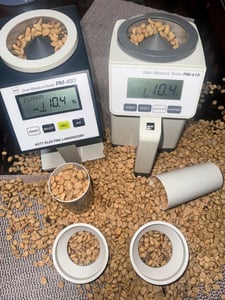 If you rely on a daily ‘cup of ambition’ to help you tumble out of bed, that means that each morning, you’re ingesting one of the top two most traded commodities in the world, second only to petrol fuels. Global coffee production has really taken off since 2000, when 6.5 million tons of coffee were produced annually. Today, over 9 million tons of coffee are produced yearly to keep up with the demand for the brewed beverage that is only surpassed by water in terms of global consumption.
If you rely on a daily ‘cup of ambition’ to help you tumble out of bed, that means that each morning, you’re ingesting one of the top two most traded commodities in the world, second only to petrol fuels. Global coffee production has really taken off since 2000, when 6.5 million tons of coffee were produced annually. Today, over 9 million tons of coffee are produced yearly to keep up with the demand for the brewed beverage that is only surpassed by water in terms of global consumption.
More than 25 million people—mostly farmers and agricultural workers—rely on coffee crops to earn their livelihood. And like other farmers, profit margins for coffee farmers can be razor-thin. It’s estimated that for a $4 cup of coffee, today’s farmers earn about $0.04, or just about 1% of the profits.
What does this mean for coffee farmers? It means that maximizing the harvest of coffee cherries to be dried and processed into usable beans is essential for farmers looking to make the most of their already tight profit margins.
Here is what you need to know about the optimal time to harvest coffee for fresh, quality beans—and how Kett’s laboratory-quality instruments can help optimize crop quality and output.
Coffee Bushes: Growing from Seed to Cherry
While coffee beans can give consumers the caffeinated ‘get-up-and-go’ they need to speed through the day, the actual process of growing and harvesting coffee from seed is a slow endeavor.
Typically, coffee plants don’t start producing harvestable fruit until they are 3 to 4 years old. By the time these bushes reach 7 years old, they hit peak production when farmers in some areas may harvest up to two coffee crops per year depending on the regional climate.
If you work in the coffee industry, you likely know that coffee beans start as little white flowers. These blooms pop up all along the plant’s stems and give off a sweet smell comparable to jasmine. After about a month, these flowers wilt, turn brown, and fall off, leaving tiny green berries—also called cherries—in their place.
Over time, these cherries ripen, turning from a vibrant green to a deep red. If coffee cherries are not harvested in time, they turn brown or black and are no longer viable for coffee production. Ripe coffee cherries usually contain two coffee “beans,” each encapsulated in a thin, papery covering known as parchment, as well as a layer of pulpy fruit. After harvest, coffee cherries must be dried and cleaned of fruit before they are ready for further processing [link to “Coffee Processing: Wet vs Dry Methods and How Kett Can Help” blog].
When Is the Best Time to Harvest Coffee Cherries?
When coffee cherries turn red (or yellow for some varietals), the flavors mature and deepen, creating its signature rich, full taste. This color change is a good indicator that it is probably a good time to harvest. Depending on the climate, there may be one harvest period sometime between October and December, or two harvest periods, with the second happening sometime between April and June.
In many places, coffee beans are harvested by hand, but if the topography is flat and spread out—like in Brazil, for example, coffee cherries may be machine harvested. But here is where things get complicated: Coffee cherries don’t all mature at the same time. Some cherries ripen and turn red faster than others, which remain green (and unviable for processing) longer.
If cherries are harvested by hand, they may be selectively picked, leaving unripened fruit on the branch. However, in many instances, coffee trees are strip-picked of all fruit, including the green, underripe cherries. These green cherries produce a sour-tasting coffee, while coffee beans processed from overripe cherries may ferment, negatively impacting the flavor of the final product when brewed.
Selective picking of mature coffee cherries may be preferred for high-quality or exclusive coffee, but it is also very labor-intensive and expensive. Some large coffee farms that cover hundreds of acres may require machine harvests to keep labor costs affordable. Each farmer will take their own approach to harvesting their coffee crop depending on factors that include:
- The quality of the coffee beans
- Their access to machinery for harvest
- The total number of workers on hand to harvest and their budget for labor
Whether farmers employ selective or strip-picking methods of harvest may also depend on the region. Costa Rican coffee crops often supply specialty coffee markets, and therefore much of the coffee there is picked by hand. In Brazil, only a few bespoke crops are harvested by hand, and in Ethiopia, the method of harvest depends on whether the coffee is grown and harvested in the wild or on a dedicated farm.
When is the best time to harvest? It depends. Many variables play into when coffee cherries are ripe and ready for picking, including:
- Altitude
- Total rainfall and moisture
- Soil pH and nutrient quality
- Temperature
- Health of the plant
For this reason, even crops in the same region may have their own optimal time for harvest.
Coffee Crops and Moisture Content
 At harvest time, coffee beans are higher in moisture content than most other crops which must dry before harvest. Unprocessed, fully-ripened coffee beans have a moisture content of somewhere around 45 to 55 percent moisture. After processing and drying, coffee beans should have a moisture content of 10 to 12 percent to prevent spoilage, fermentation, or the formation of mold or mildew.
At harvest time, coffee beans are higher in moisture content than most other crops which must dry before harvest. Unprocessed, fully-ripened coffee beans have a moisture content of somewhere around 45 to 55 percent moisture. After processing and drying, coffee beans should have a moisture content of 10 to 12 percent to prevent spoilage, fermentation, or the formation of mold or mildew.
On specialty farms where elite coffee beans are grown, farmers must monitor moisture levels so they are only picking the cherries that are ripe and ready for harvest. From this point on, farmers must label each batch or harvest, and then monitor moisture content levels during processing. They must also keep batches separate to not mix different harvests that have different moisture levels. This is because beans with different moisture levels will roast inconsistently, with some beans roasting faster or slower than others.
For farmers, this can majorly affect business, as a batch of inconsistently roasted beans may cause a roaster to take their business elsewhere.
During harvest, processing, and roasting, a coffee crop’s moisture levels are essential to the final quality and taste and must be carefully monitored. Kett’s PM650 Instant Grain and Seed Moisture Meter is non-destructive and easy to use. It also includes preset factory calibrations tailored to assessing moisture levels of coffee crops, including:
- Raw coffee for dried coffee cherries
- Green coffee bean moisture levels
- Roasted coffee bean moisture levels
- Parchment coffee moisture levels for Arabica coffee
- Parchment coffee moisture levels for Robusta coffee
The PM650 Moisture Meter provides farmers with highly accurate, factory-caliber moisture readings in the field instantly, without losing valuable time in processing samples for testing. Essentially, it allows busy coffee farmers and agricultural workers to get accurate readings and return to work faster.
To learn more about how Kett’s instruments can help optimize the harvest, drying, roasting, and processing of coffee beans from branch to brew, contact us today!

